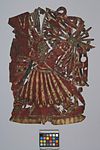tholu bommalata (Shadow Puppet)
About this object
History of use
Puppetry, particularly shadow puppets, is an ancient dramatic form in India mentioned in the Buddhist Jataka Tales of the 3rd century B.C.E. Nowadays modern forms of entertainment, such as the Hindi film industry, have rendered them extinct except for some rural areas in the states of Orissa, Kerala, Andhra Pradesh, and Tamil Nadu. The Andhra Pradesh/Karnataka shadow puppet tradition, compared to the few remaining troupes, are the most extensive and dramatic. Probably originally Maharashtran and maintained by dynasties, such as the Vijaynagars of the 13th and 14th centuries, it now survives as presented by Marathi-speaking puppeteers, commonly called Raoji. These are the largest in size of the Indian shadow puppets.
Iconographic meaning
Representation of Koda (Kodur) Rama, 'Rama of the bow'. Rama, meaning 'charming', is the embodiment of righteousness and an incarnation of the solar aspect of Vishnu. The marks of Vishnu are visible on this puppet's head. He is a key figure in the epic, Ramayana. He is armed with the magical bow of Indra and arrows of silver and gold given to him by the sage, Agastya. The battle dress of this puppet is typical of the Maharashtran Style as are his large shoes.
Physical description
A shadow puppet of transparent leather cut out representing a warrior. Face is at once both frontal and in profile view. Wearing a slender, high crown, with floral decoration, along with a striped shirt. Arms are drawn back in position to shoot a bow. Arrows are displayed in circular design motif. Dyed green, red, and black.
